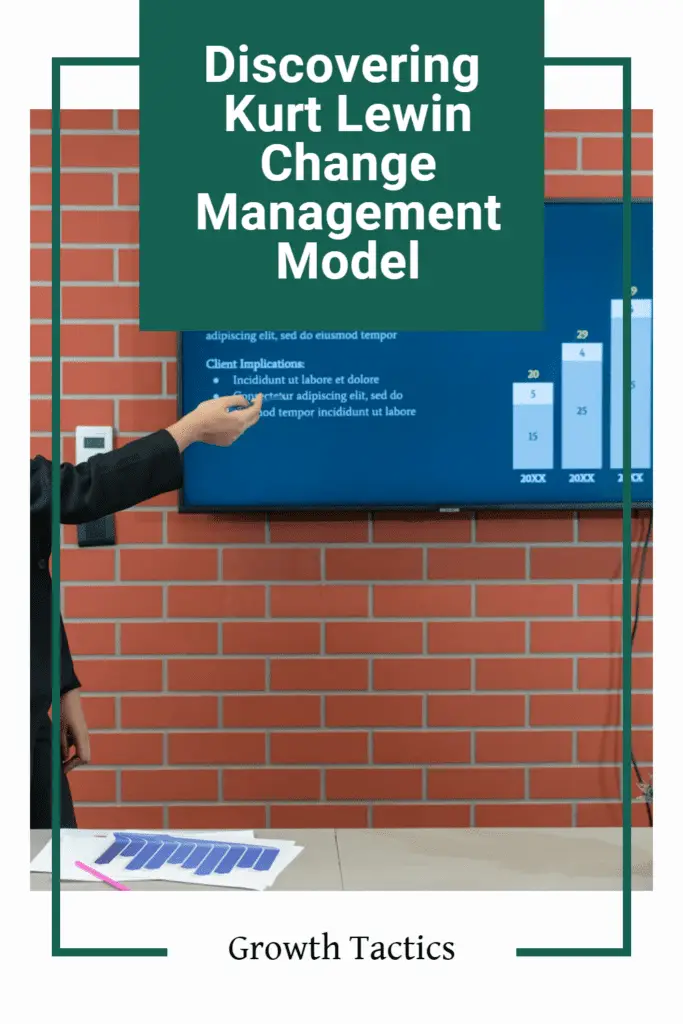Are you ready for a deep dive into the world of change management? In this article, we’ll explore the renowned change management model developed by Kurt Lewin and how it can help organizations navigate the complexities of change. Whether you’re a business leader or simply curious about the dynamics of organizational change, this article will provide valuable insights to guide you on your journey. So, let’s get started!
Jump To Section
Understanding the Kurt Lewin Model: Unfreezing, Changing, and Refreezing

What is the Lewin Change Management Model?
Change is a constant in life, and it’s no different in the world of business. That’s where the Kurt Lewin change management model comes in. It’s a structured approach that helps organizations navigate and effectively manage change. This model is broken down into three key stages: unfreezing, changing, and refreezing. Let’s take a closer look at each of these stages to understand how they contribute to successful change management.
Exploring the Three Stages of Change Management
Now that we have a basic understanding of the Lewin model, let’s delve deeper into each of the three stages and explore how they contribute to successful change management.
Unfreezing: Recognizing the Need for Change
During the unfreezing stage, it’s essential to create a sense of urgency and cultivate a shared understanding of why change is necessary. By assessing the current state of the organization and identifying pain points or areas for improvement, leaders can build a compelling case for change. Effective communication plays a vital role here, as it helps employees understand the need for change and addresses any concerns or resistance.
One key aspect of unfreezing is acknowledging that change can be uncomfortable and unsettling. It’s natural for individuals to resist change, especially if it disrupts their routines or perceptions of stability. By providing support and addressing concerns openly and honestly, leaders can help employees embrace the impending change and motivate them to take part in the journey.
Changing: Implementing Transformation
As the organization enters the changing stage, it’s time to put the plans into action. This involves implementing the strategies and initiatives designed to bring about the desired change. Clear communication channels, effective project management, and continuous monitoring are critical at this stage to ensure a smooth transition.
Change efforts may encounter obstacles or resistance along the way. It’s essential to address these challenges proactively and involve key stakeholders in problem-solving and decision-making. By providing support, resources, and training, employees can feel empowered and equipped to navigate the change successfully.
Refreezing: Anchoring the Change
The final stage of the Lewin model is refreezing, where the focus shifts towards solidifying and anchoring the changes made. This stage is essential for sustaining the progress achieved during the change initiative and preventing a return to old habits or practices.
During refreezing, it’s important to align systems, processes, and behaviors with the new vision and objectives. This may involve restructuring workflows, updating policies and procedures, or providing coaching and development opportunities to support employees in adapting to the new ways of working. Regular evaluation and feedback mechanisms can help identify any gaps or areas for improvement, ensuring the change becomes deeply ingrained within the organization’s culture.

Tips for Success With the Lewin Change Model
Change management can be a daunting task, but it doesn’t have to be! The Lewin Change Management Model offers a structured approach to help organizations navigate and drive successful transformations. In this section, we’ll dive into some practical tips for effectively implementing the Lewin Model and achieving positive change. Let’s get started!
Tip #1: Take Time to Unfreeze
In the unfreezing stage, it’s crucial to create awareness and acceptance for the need for change. This is where we break away from the status quo and set the stage for transformation. Take the time to communicate the rationale behind the change and engage stakeholders. By establishing the need for change early on, we can minimize resistance and lay the foundation for a smooth transition.
Tip #2: Embrace a Continuous Learning Mindset
Change management is an ever-evolving field, and it’s important to stay up-to-date with new approaches, tools, and techniques. Embrace a continuous learning mindset to enhance your change management skills. By seeking new knowledge and staying ahead of the curve, you can navigate the changing business landscape more effectively and deliver better results.
Tip #3: Be Open to New Ways of Doing Things
Successful change requires embracing new ideas, systems, and processes. It can be uncomfortable, but it’s essential to be open to new ways of doing things. By fostering a culture of innovation and experimentation, we encourage creative thinking and inspire new solutions. Embrace the possibilities that change offers and seize the opportunities for growth and improvement.
Tip #4: Encourage Employee Involvement and Engagement
Employees play a vital role in any change initiative. To drive successful transformations, create opportunities for employee involvement and engagement. When employees are actively involved in the process, they develop a sense of ownership and commitment. Foster open communication, collaboration, and provide support to ensure employees feel valued and ready to embrace the change.
Tip #5: Monitor, Evaluate, and Adapt
Change is a dynamic process, and it’s crucial to monitor, evaluate, and adapt along the way. Regularly review the progress of the change initiative, gather feedback, and make adjustments as needed. By being proactive in addressing any roadblocks or obstacles, you can ensure the change becomes embedded in the organization’s culture. Stay agile and responsive to keep the transformation on track.
The Crucial Role of Leadership in Change Management
Change management is like setting sail on a vast ocean of transformation. And just as a captain guides a ship through turbulent waters, strong leadership is essential to navigate the tides of change. In this section, we’ll explore the crucial role that leadership plays in change management and how it can make all the difference in the success of your change initiatives.
Setting the Direction: Inspiring a Clear Vision
Leadership sets the course for change by inspiring a clear vision. Effective leaders articulate the “why” behind the change and help employees understand the purpose and benefits of the transformation. By painting a compelling picture of the future, leaders create a sense of urgency and enthusiasm that propels the organization forward. This shared vision serves as a guiding light, ensuring everyone is aligned and moving in the same direction.
Active Communication: Open, Transparent, and Engaging
Communication is the anchor that holds a change initiative together, and leaders must wield it skillfully. They must foster an environment of open dialogue, where employees feel comfortable expressing their thoughts and concerns. Through active communication, leaders keep everyone informed about the progress, milestones, and challenges. This transparency builds trust and allows for timely adjustments, ensuring that the change remains on track.
Leading by Example: Walking the Talk
Actions speak louder than words, and leaders must lead by example. When leaders actively embrace change, show enthusiasm, and adopt new behaviors, it inspires and motivates employees to do the same. By demonstrating their commitment and willingness to adapt, leaders set the tone for the entire organization. This creates a culture where change becomes the norm, making future transformations more seamless.
Empowering Others: Encouraging Employee Ownership
In change management, empowering employees is like hoisting the sails that propel the ship forward. Effective leaders delegate authority and provide employees with the autonomy to make decisions. By encouraging employee ownership and involvement in the change process, leaders create a sense of accountability and commitment. This fosters a culture of engagement and innovation, where individuals feel empowered to contribute their unique ideas and expertise.
Overcoming Resistance to Change: Addressing Challenges Head-On
Change can be met with resistance, but strong leadership helps overcome these challenges. Leaders actively listen to the concerns of employees and address them with empathy and understanding. They provide support, resources, and training to help individuals adapt to the change. By involving employees in problem-solving and decision-making, leaders reduce resistance and increase buy-in, paving the way for a smoother transition.
Celebrating Success: Recognizing Milestones Along the Way
As the ship sails further into the sea of change, leaders play an important role in celebrating success. Recognizing and celebrating milestones, both big and small, boosts morale and maintains momentum. Leaders acknowledge the hard work and contributions of individuals and teams, reinforcing the value of the change and encouraging continued commitment.
In conclusion, the role of leadership in change management is paramount. Leaders set the direction with a clear vision, communicate actively, lead by example, empower others, overcome resistance, and celebrate success. Through their guidance and support, leaders steer the organization through the waves of change, ensuring a successful transformation. So, set sail with strong leadership and embrace the winds of change for a brighter future.

The Impact of Culture: Fostering Change-Ready Organizations
When it comes to change management, organizational culture plays a pivotal role. Imagine your company as a garden, and culture as the fertile soil in which the seeds of change are planted. A culture that values innovation, experimentation, and collaboration can cultivate an environment where change initiatives take root and flourish. In this section, we’ll explore the profound impact that culture has on change management and how assessing and improving your existing culture can pave the way for a more change-ready organization.
The Power of a Culture that Embraces Innovation
Innovation is the key that unlocks the door to successful change. A culture that embraces innovation encourages employees to think outside the box, challenge the status quo, and seek new solutions. This mindset creates an atmosphere where change is seen as an opportunity for growth, rather than a disruptor. By fostering a culture of innovation, organizations can harness the creative potential of their workforce and navigate change with agility and adaptability.
Experimentation: Cultivating a Culture of Learning
Change often brings unknowns and uncertainties. A culture of experimentation, however, sees these challenges as valuable learning opportunities. When employees feel empowered to take risks and try new approaches, they become more resilient and adaptable in the face of change. Experimentation fosters a growth mindset, enabling individuals and teams to learn from both successes and failures. By embracing experimentation, organizations create a culture that thrives on continuous improvement and can better navigate the ever-changing landscape of change.
Collaboration: Strength in Unity
Change management is a team sport, and a culture of collaboration is the winning formula. When employees collaborate across departments, share knowledge and insights, and work together towards a common goal, change initiatives gain momentum. Collaboration breaks down silos, enhances communication, and promotes collective ownership of the change process. By fostering a collaborative culture, organizations can tap into the collective intelligence and experience of their workforce, leading to more effective and sustainable change.
Assessing and Improving Your Organizational Culture
To create a more change-ready organization, it’s crucial to assess and improve your existing culture. Start by conducting a cultural assessment to understand the current norms, values, and behaviors within your organization. Identify areas where the existing culture aligns with the values necessary for change, and also uncover any gaps or obstacles that may hinder progress. With these insights, develop strategies to enhance your culture, such as promoting open communication, encouraging experimentation, and recognizing and rewarding innovative thinking.
Embrace the Power of Culture for Successful Change
Organizational culture has the power to either propel or hinder change management efforts. By fostering a culture that values innovation, experimentation, and collaboration, organizations can create an ecosystem where change initiatives thrive. Assessing and improving your culture allows you to create the ideal environment for change to take root. So, embrace the power of culture on your change journey, and watch as your organization becomes more change-ready and ready to embrace a future full of possibilities.
Wrap Up: Your Journey to Successful Change
The Lewin Change Management Model provides a structured roadmap for navigating change effectively. By applying these practical tips, you can harness the power of the model and achieve successful transformations within your organization. Remember to unfreeze, embrace a continuous learning mindset, be open to new ways of doing things, encourage employee involvement, and monitor, evaluate, and adapt. There’s no limit to what you can achieve with the right approach to change management. Best of luck on your journey!
Key Takeaways
- Change is an inevitable part of organizational life, and the Kurt Lewin change management model offers a structured approach to navigate and facilitate the change process.
- The three stages of the Lewin model are unfreezing, changing, and refreezing.
- Unfreezing involves creating awareness and acceptance of the need for change, changing focuses on implementing the change effectively, and refreezing aims to anchor the change within the organization.
- Effective communication, stakeholder engagement, and addressing resistance are crucial throughout all stages of the change management process.
- By applying the Lewin model, organizations can navigate complex change scenarios more successfully and increase the likelihood of sustained transformation.


